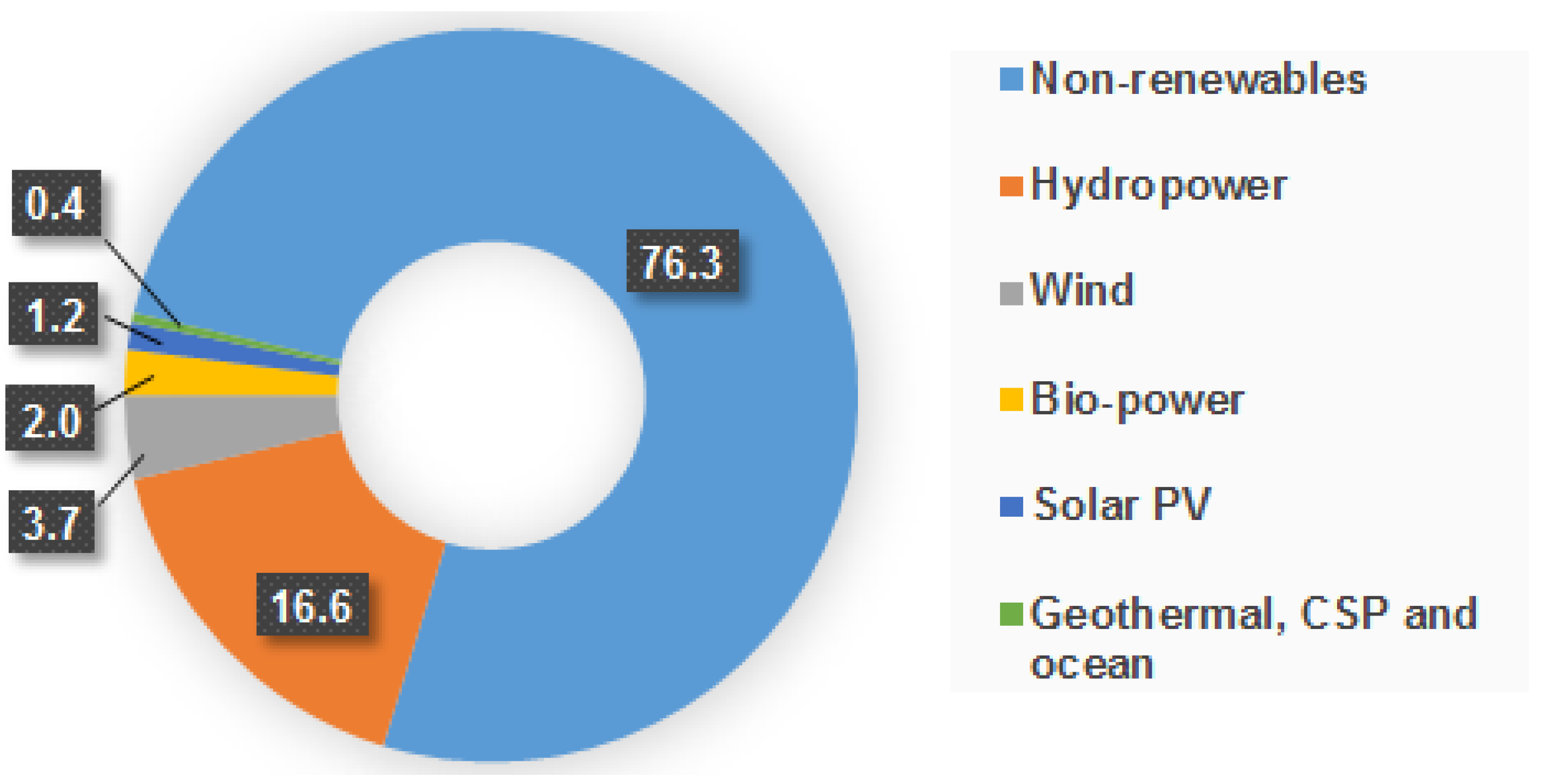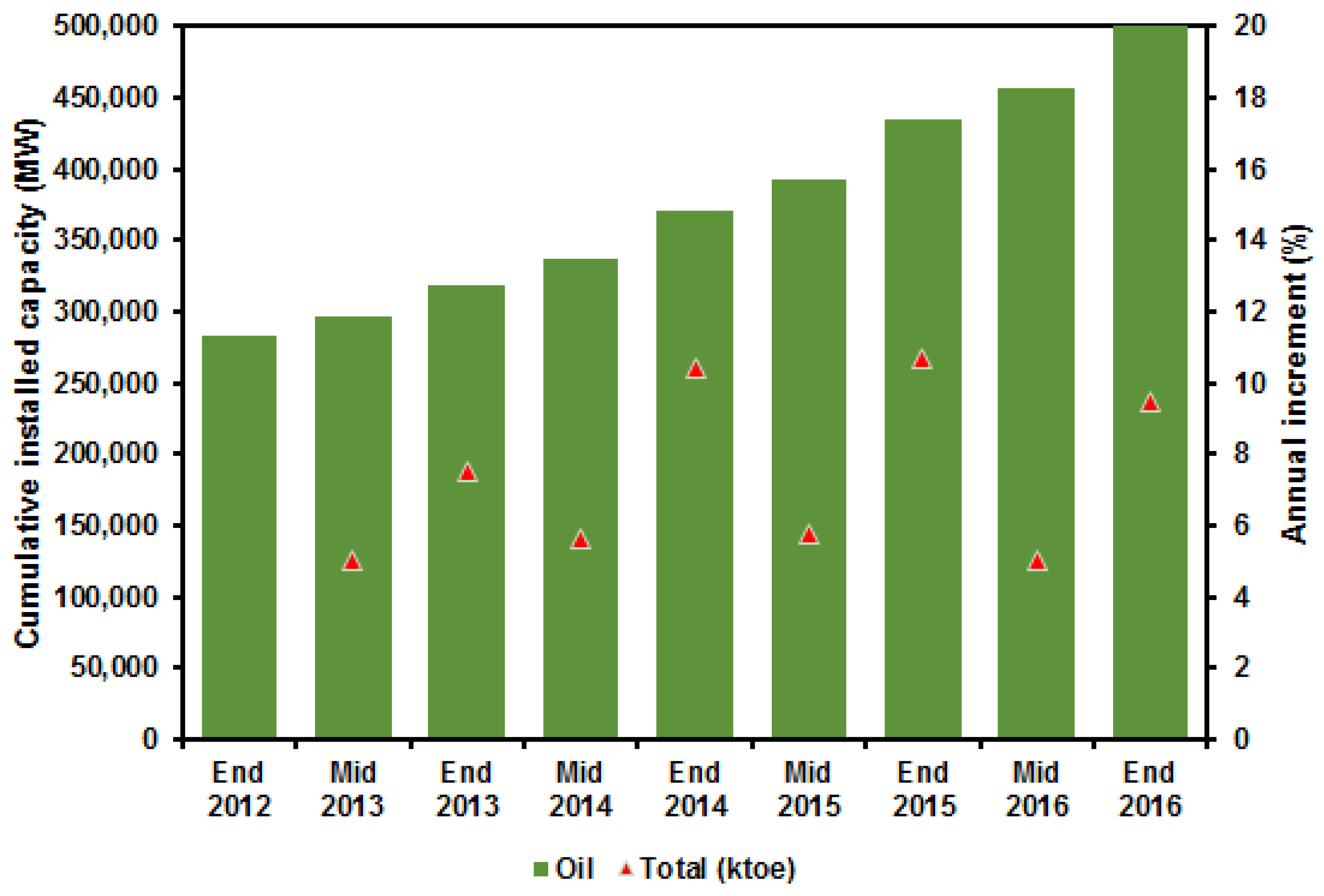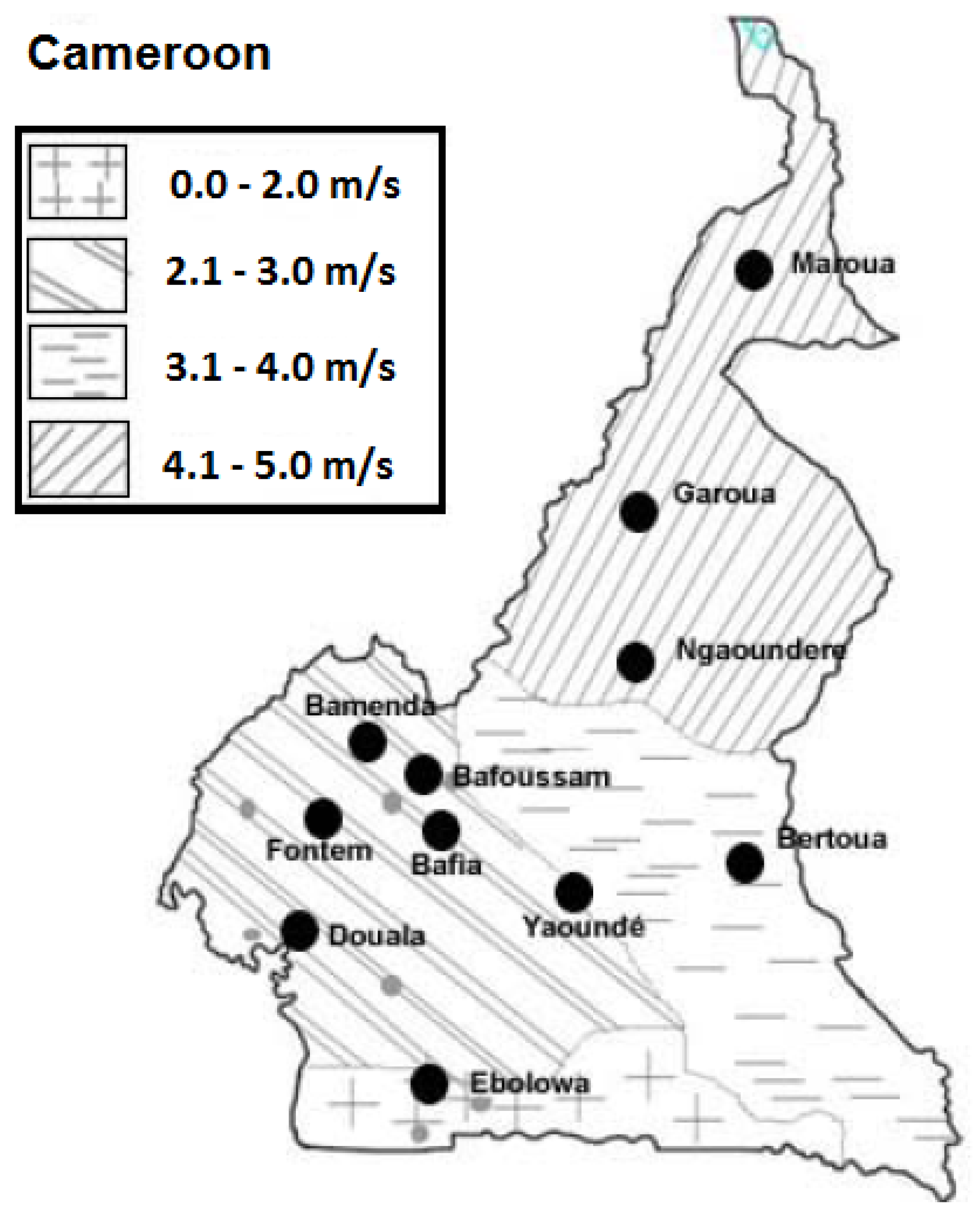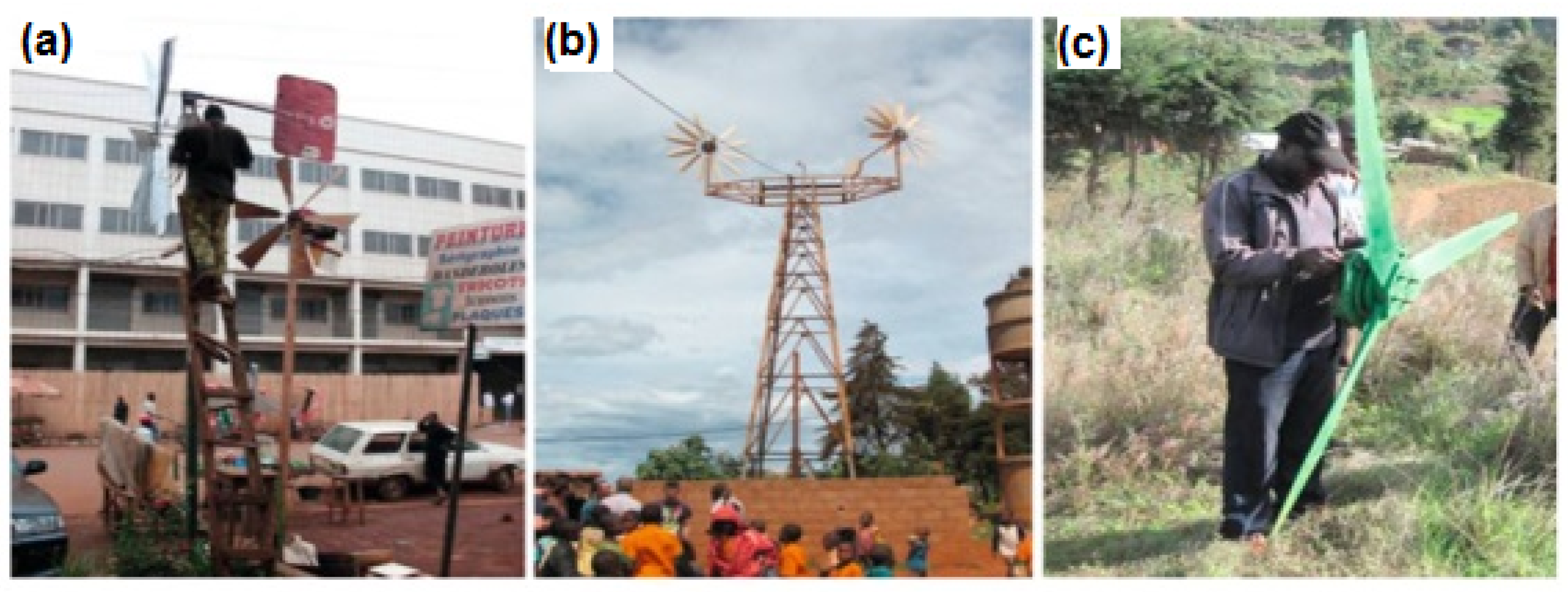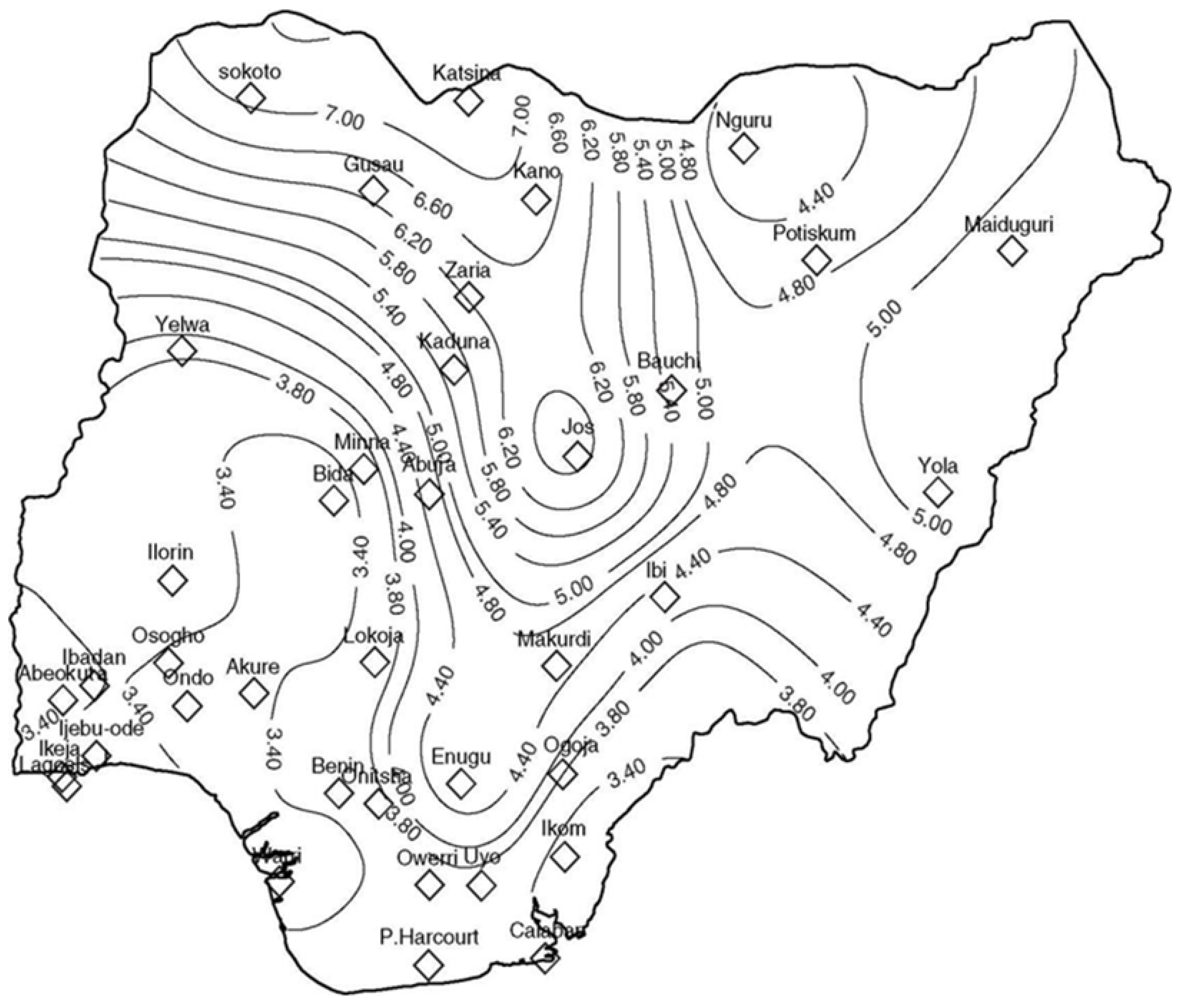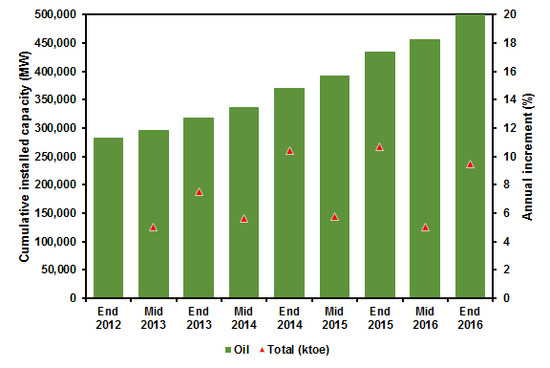1. Introduction
Due to the world technological advancement and rise in population, energy has become an important unit for the dwellers of the global village. Sadly, in this current era, some developing countries in the world are short of electricity supply due to the increase in energy demand. Currently, in most parts of the world, fossil fuels and other non-renewable energies have been the primary power sources, but recent investigation shows that they are depleting rapidly [
1]. There is the problem of pollution with non-renewable sources with serious environmental and health effects. These challenges bring about the need for renewables in the future energy mix of many countries in the world.
By the end of 2015, renewables comprised approximately
% of the global electricity generation (see
Figure 1), with hydro-power supplying up to
% [
2]. Though there are high renewable energy (RE) potentials globally and the share of renewables in world electricity production is growing, it is still insignificant compared with the conventional sources. Currently, most renewable additions vary from country to country coupled with the increase in electricity demand [
2]. Among these renewables, wind technologies supply just about 3.7% of world electricity production [
2,
3].
There are several advantages of wind power, which are [
4]: easy to tap; easier installation of the wind turbines when compared with others (e.g., hydro turbine technologies or marine technologies) regarding space allocation and installation time; flexibility of locating wind farms, i.e., onshore and offshore, among others. Despite the advantages of wind power, there are concerns regarding its negative social and environmental impacts [
5] and about large-scale infrastructural development that requires proper understanding [
6]. There are observed effects of such impacts on landscaping, noise generation, disputes with communities and land use issues [
2,
5]. Though the cost of wind generation has fallen rapidly over the last decade, the public financial support for wind energy continued decreasing and hinders the development of several wind farms projects globally [
3]. Despite all of these issues, wind power is still more applicable and profitable compared to other renewable energies and, in some cases, competitive with traditional sources.
The world installed wind capacity rose to 456 MW in 2016 and will reach 500 GW by the end of the year, as illustrated in
Figure 2 [
7]. This is an indication that wind power markets are still active. At the end of 2015, Europe has installed wind power capacity of 147,771 MW, Africa and the Middle East 3289 MW, North America 88,744 MW, Latin America and the Caribbean 12,220 MW, Asia 175,573 MW and the Pacific region 432,419 MW [
3]. Asia has the highest growth capacity, while Africa and the Middle East have the lowest growth capacity at the end of 2015 [
3]. Despite high wind potential in Africa [
8], there is a significant gap between the potential and the level of implementation. This raises grave concern regarding the development of wind farms projects in the continent.
All wind turbines installed worldwide by June of 2016 can generate around 4.7% of the world’s electricity. The top 10 new installed capacity by country in 2016 is presented in
Table 1 [
7].
Since 1990, Germany has already adopted wind energy as its primary RE source [
9], and tremendous savings in fossil fuel have been achieved. Germany is the largest wind market in Europe in 2015 with an installed capacity of 44,947 MW of which 70% is offshore [
3]. Wind energy contributes about 7.8% of Germany’s net electricity consumption. In essence, wind power is the major contributor among the RE sources in Germany. Apart from Germany, Poland has the second largest market for wind power in Europe in 2015 with installed capacity of 13,603 MW, with 1266 MW new installations by the end of 2015 [
3]. Other countries in Europe like France and Turkey have also made tremendous progress regarding wind farm projects [
3]. Turkey is another country with rapid growth in wind energy development. In Turkey, wind power potentials are estimated at 47 GW, and the installed wind capacity is forecasted to rise to 1000 MW per year [
10]. Part of the RE plan of Turkey is to install up to 20 GW of wind turbines by the year 2023 [
11].
In comparison to the rest of the world, Africa possesses tremendous unexploited wind energy potentials. Recently, some African countries have already installed wind farms [
12]. Currently, South Africa, Morocco, Egypt and Tunisia have the largest wind power capacity in the continent, 1053 MW, 787 MW, 610 MW and 245 MW, respectively, at the end of 2015 [
3,
13]. Africa nowadays is at the bottom of the list of global installed wind power capacity [
3]. Despite this progress in Africa’s supply of wind energy, the total capacity of the wind installation in Africa accounts for about 0.4% of the world capacity [
14], and this data reflect the need to further strengthen the growth of wind energy on the African continent. The weak growth of wind farms in Africa is due to the lack of clear policies in many countries. Besides, there is no detailed information available at project levels, which may hinder stakeholders and private individuals in understanding the market fully.
Among the developing countries, Cameroon and Nigeria are countries with abundant wind energy sources. In the case of Cameroon, the energy supplies from all sources are lower than the demand, and the country is heavily dependent on hydro-power [
5], but this hydro-power is not readily available in all parts of the country. Hydro-power appears to be insufficient to supply the demand during the dry season, but wind power potentials seem to be at their peak during this period and can be seriously considered to supplement the hydro-power shortfalls [
14]. The lack of stable RE policies over time, wind inclusive, are an obstacle to the development of the power system in Cameroon. Both Cameroon and Nigeria have power system infrastructure that is old and that needs to be upgraded to ensure proper functioning with the inclusion of future non-manageable renewable sources [
5,
15,
16]. For the upgrade of the infrastructure, policies based on natural resources can be explored, such as subsidies from the exploitation of oil, among others [
17,
18]. The energy potential in Africa allows one not only to develop wind projects onshore, but also offshore [
19,
20]. Cameroon and Nigeria have large cities near the coasts, which could mean a development vector to drive offshore wind farm projects. This type of infrastructure has high costs compared to conventional projects onshore; however, it is necessary to consider them since the costs of investment and operation are becoming smaller [
18,
21]
On the other hand, a literature review [
22,
23,
24,
25] shows that a combination of energy sources (solar, wind, biomass and hydro) is one of the solutions to the current power crisis in Nigeria and can meet the electricity demand of the rural dwellers. Furthermore, the stability and coverage of supply in Nigeria could be improved. There exists an energy policy in Nigeria, but the implementation is going at a slow pace. For South Africa, wind power has already gathered steam, and it is currently one of the leading countries in Africa regarding renewable. Several wind farms have been installed and integrated into the grid.
This paper critically studies the current wind power development, policies and challenges in Cameroon and Nigeria and proposes the way forward. Specifically, lessons from South Africans’ success in wind energy are discussed. The outline of the paper is as follows.
Section 1 is the Introduction.
Section 2 describes the current energy situation in Cameroon and Nigeria, while
Section 3 evaluates the wind energy potentials in both countries, looking at their current and future installations. Then,
Section 4 presents the energy policies in Cameroon and Nigeria before discussing the challenges in developing wind energy in those countries in
Section 5. Afterwards,
Section 6 reviews the wind energy resources and policies in South Africa before suggesting some lessons that can be learned for Cameroon and Nigeria in
Section 7. Finally,
Section 8 lays out the conclusions and the way forward for the two countries.
6. Wind Energy Resources and Policies in South Africa
South Africa, a developing country in Africa, gained its independence as a republic in 1961, about the same time as Cameroon and Nigeria. However, South Africa is considered to be among the African countries that are progressing well in RE, specifically in the development of wind for power generation [
3]. The wind speed in South Africa is estimated to be between 7.2 m/s and 9.7 m/s around Cape Agulhas and Cape Point [
60], which is slightly higher than Cameroon and Nigeria. The wind energy potentials in South Africa are estimated to be 26,000 GWh annually [
61]. South Africa has promising wind resources, as can be seen in
Figure 9 [
62]. The greatest wind energy potentials are in the coastal zones and the tops of the mountain ranges.
In 2015, a total of 483 MW of wind power was added to South Africa electricity grid, bringing the cumulative capacity to 1053 MW. During 2016, there was a considerable development, where several large wind farms are now fully operational, and much more are under construction. The development of South Africa’s wind industry and market has taken place in the last four years, being a relatively short period compared with other countries. Nowadays, South Africa is at the top list of wind markets globally; this development is beneficial in strengthening the industry and its supply chain [
3].
The Integrated Resource Plan of South Africa has a goal to develop 9 GW of wind power by 2030 [
63]. However, the South African Wind Energy Association expects this figure to rise by a wide margin and about 15 GW of projects to be installed by 2030. The development of wind technologies that are necessary, like RE, is a good source of new power that can be deployed quickly enough to solve South Africa’s needs and goals. Small sized solutions have advantages associated with their ease of construction and short time periods for installation. Wind farms, for instance, can take less than a year to build. The size of renewable plants allows a gradual growth that can match more precisely the increase in demand [
3].
The Government of South Africa has already adopted policies, acts, strategies and task teams for the development of RE. Since 1998, the Government of South Africa believes that renewable can provide savings in energy with consideration of social, economic and environmental cost. This led to the development of the White Paper of 1998 [
64]. The White Paper particularly mentioned that the government would place immediate emphasis on programs such as biomass applications, photovoltaic (PV), passive building design, micro-hydro, wind-based electricity systems and solar water heating. The objective of the 1998 White Paper is as follows [
64]:
Improve access to energy services.
Improve the governance of the energy in the context of transparency and accountability.
Encouragement of economic development.
Effectively manage environmental and health effects of energy.
Secure the power supply through diversity.
Afterwards, the 2003 White Paper was released [
65], where the South African government clearly stated that to meet its long-term objectives for a sustainable energy industry, a ten-year target plan must be set up. The RE should contribute about 10,000 GWh to the final energy consumption by 2013, which must be from the wind, solar, biomass and small-scale hydro. By the end of 2003, the Integrated Energy Plan (IEP) was made public. This plan developed an approach of taking actions related to energy policy and to efficiently enhance the energy sources and their technologies in the country. The IEP was developed based on the energy demand and consumption up to the year 2020 by considering the different economic scenarios for South Africa [
65,
66].
In late 2005, the South African government established the Renewable Energy Finance and Subsidy Office. The Office’s responsibilities include the management of RE subsidies and providing advice to other stakeholders and developers on RE finance and subsidies, including the size of awards, eligibility and procedural requirements.
Table 7 shows the summary of the energy policy and actions related to RE in South Africa.
8. Conclusions
This paper has evaluated the wind energy potentials in Cameroon, Nigeria and South Africa. Among them, in Cameroon, there is heavy dependence on hydro-power, which is not readily available in all parts of the country, especially in the dry season. During this season, wind has the capability to complement hydro in generating electricity because its potential is at the peak. Presently, there is a lack of clear RE policy in Cameroon that can accelerate the development of wind as an alternative source of electricity in the country. Several organizations have attempted to install wind turbines in some parts of the country, but to date, have produced no progress. Lack of maintenance and commitment from the Cameroonian policy makers has hindered the process. In Cameroon, there is a need for clear wind energy policy that covers certain aspects of research, manpower development and encouraging extension programs that can facilitate the general application of wind power technology. The Cameroonian government shall be fully involved in carrying out feasibility studies for the implementation of wind turbines especially in rural areas with no access to electricity. There is also a need for the Cameroonian government to critically assess the integration of wind farms into the national grid and possible wind farms sites. The Cameroonian government should carry out sponsored research on the voltage and reliability studies on wind power in several parts of the country to be aware of any consequences on the power system as a result of the wind integration.
For Nigeria, the country is yet to have a working wind farm despite vast wind potentials. In Nigeria, there is a clear policy available to the public, but its implementation is slow. Though Nigeria has set up research and development centres for wind energy, there are some challenges, which include inadequate funding from the government, manpower training and development and lack of awareness by entrepreneurs to develop this sector. Currently, there are a few wind turbines installed in some parts of Nigeria, but its application is limited to water pumping and small-scale electricity generation.
South Africa has already made tremendous progress regarding RE especially in the wind sector, from which Cameroon and Nigeria can learn. Several wind farms have been commissioned and integrated into the grid on a large scale. South Africa already has a policy on RE. Since 1998, two white papers were developed and are available to the public. The two white papers have already attracted both local and direct foreign investments into the sector. Local manufacturing of wind turbines is becoming competitive. The lessons to be learned from South Africa’s wind energy progress are:
Establishment of REIPPPP to provide the platform for the government and the private sector to be committed to developing the RE program, especially wind energy;
Establish funding from donors and DFIs;
Create quality procurement and contracting documentation and processes in place;
Establishment of REFIT.
